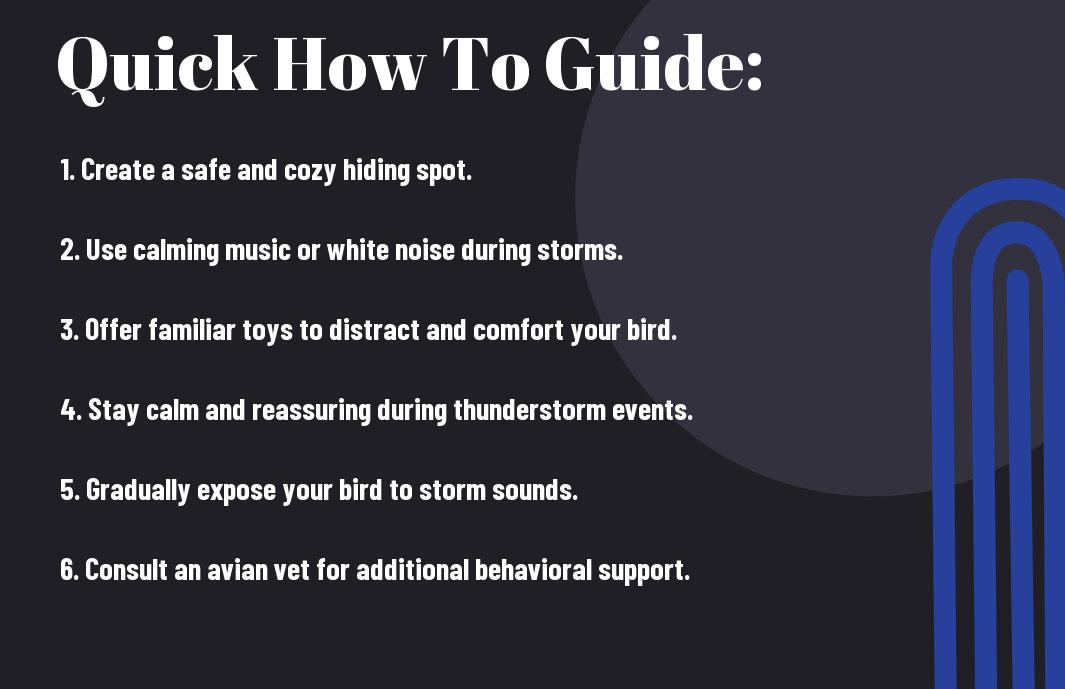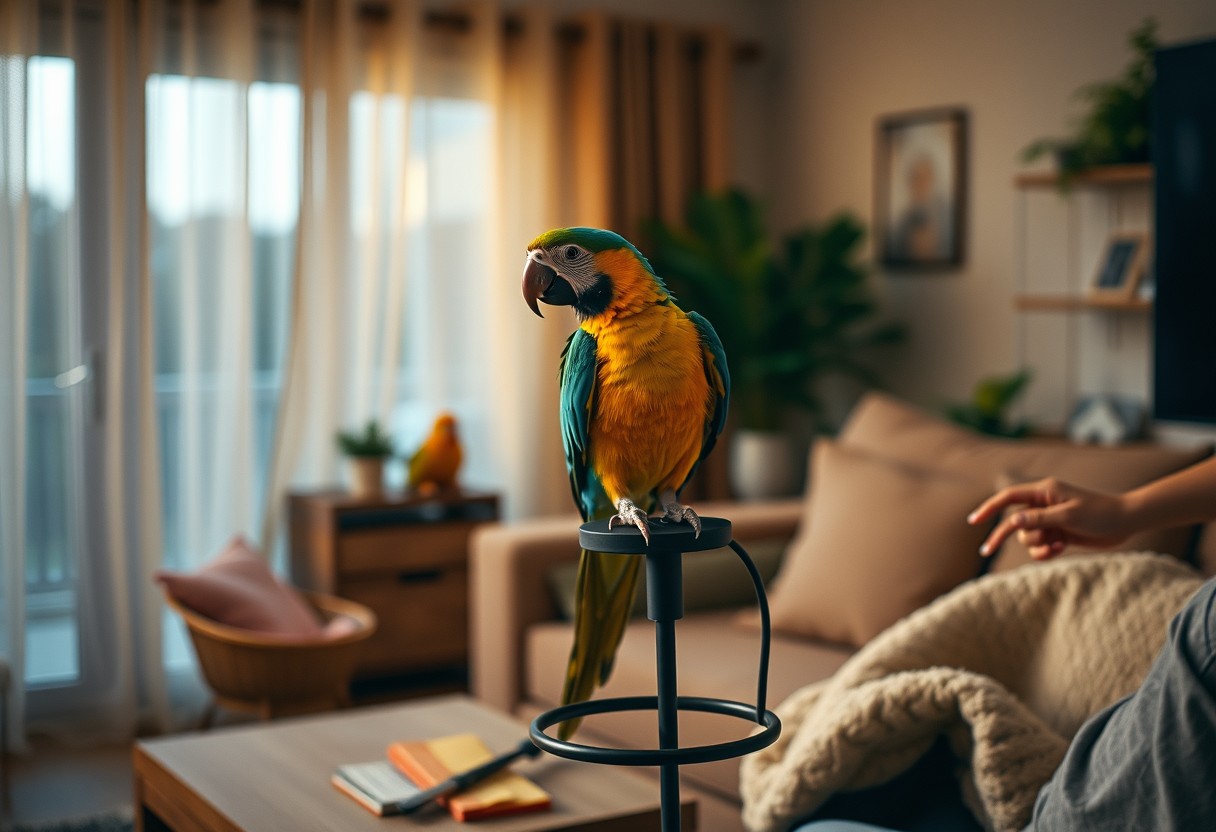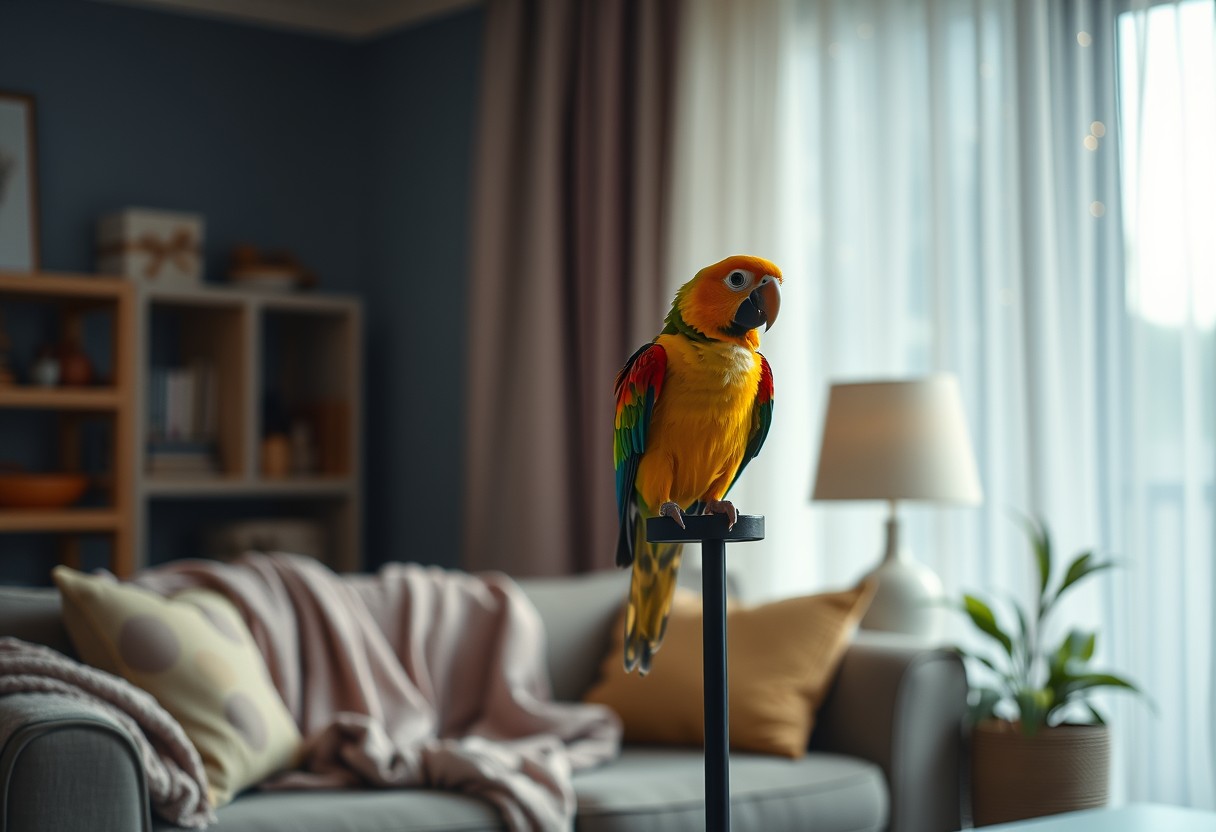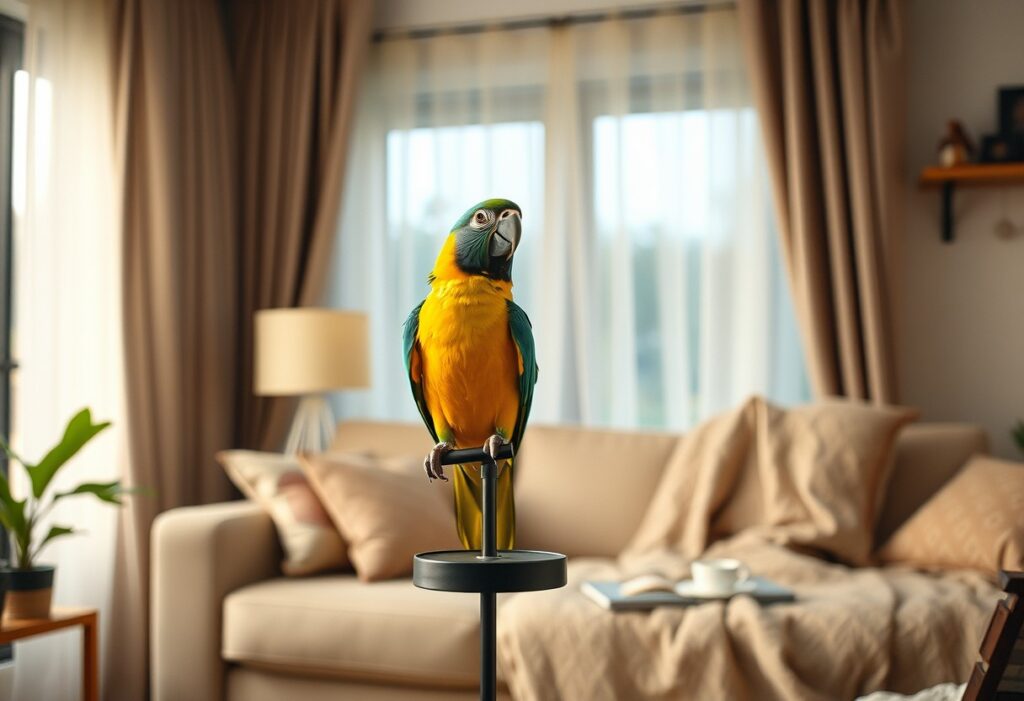Birds can be particularly sensitive to loud noises, and thunderstorms can cause significant anxiety in your feathered friend. If your bird is frightened by storms, it’s crucial for you to understand effective strategies to help manage their fear. By creating a safe space, using soothing techniques, and understanding their body language, you can ease your bird’s anxiety and ensure they feel secure during these unsettling events. In this guide, you’ll learn practical steps to support your beloved pet and promote a sense of calm during thunderstorms.


Understanding the Fear of Thunderstorms
While many birds exhibit a natural instinct to seek shelter during thunderstorms, this behavior can sometimes escalate into a phobia that impacts their wellbeing. Understanding the root of this fear is imperative in helping your feathered companion feel safe and secure when the skies turn dark. Thunderstorms are often accompanied by loud, unpredictable noises, bright flashes of lightning, and vibrations that can overwhelm sensitive bird senses, which leads to increased anxiety and distress.
Common Factors Contributing to Fear
Now, several common factors may contribute to a bird’s fear of thunderstorms. These include:
- Genetics – Some breeds may be more predisposed to anxiety than others.
- Previous trauma – Birds that have experienced distressing events during storms are likely to develop a fear of them.
- Environmental changes – Sudden changes in their surroundings can heighten fear responses.
- Isolation – Birds that are kept alone may feel more vulnerable during turbulent weather.
The combination of these factors can create a perfect storm of anxiety, making it crucial for you to recognize the signs and respond appropriately to your bird’s needs.
Signs of Stress in Birds
Common signs of stress in birds during a thunderstorm can range from mild discomfort to severe panic. You should be on the lookout for behavior changes such as excessive vocalization, feather plucking, or attempts to hide. Your bird might also exhibit physical symptoms like rapid breathing, fluffed feathers, and a loss of appetite. Understanding these signs is fundamental in providing your bird with the comfort it needs when faced with frightening weather.
Birds are creatures of habit and tend to thrive in stable environments. When faced with thunderstorms, their stress levels can spike significantly, resulting in notable behavioral changes. Observably, they may seek to hide in corners or under furniture, indicating a clear need for safety. Furthermore, stress can lead to serious health issues if not addressed, including weakened immune systems due to prolonged anxiety. Taking proactive measures to manage your bird’s fear is not just about comfort; it is vital for their long-term health and happiness.

Preparing for a Thunderstorm
Clearly, preparing for a thunderstorm can significantly reduce your bird’s anxiety and help them cope during such stressful events. Understanding that storms can be an unpredictable part of nature, you should strive to create an environment where your bird feels safe and secure. This preparation includes not only creating a safe space but also utilizing soundproofing techniques that can help minimize the impact of thunder and other loud noises on your feathered friend.
Creating a Safe Space
While every bird is unique in its preferences, setting up a designated safe space in your home can be highly beneficial. Identify a quiet, secluded room where your bird can retreat during a thunderstorm. Fill this space with their favorite toys, comfortable perches, and cozy hiding spots, such as blankets or small boxes. Make sure the room has plenty of natural light but can also be darkened if necessary—this can help mimic their natural response to danger.
Additionally, consider covering the windows with blackout curtains to further minimize distractions from lightning flashes. You should also spend time conditioning your bird to this space before the storm, encouraging them to associate it with positivity through treats and playtime. The goal is to ensure your bird feels it is a safe haven where they can relax during stressful situations.
Using Soundproofing Techniques
Thunderstorm sounds can be incredibly triggering for birds, inducing fear and panic. To help mitigate this issue, you might want to implement various soundproofing techniques within your bird’s safe space. One effective method is to use soundproofing panels or foam, which can significantly reduce external noises and protect your bird from the clamoring rumbles outside. Also, consider installing weather stripping on doors and windows to further minimize sound infiltration.
Soundproofing your bird’s safe space means that you create a less stimulating environment, allowing them to feel more secure and at ease. Additionally, using white noise machines or soft music can counterbalance the sounds of thunder, providing a calming backdrop. Ensure that the volume isn’t too loud, as this can add to their stress. By targeting the auditory distress directly with these techniques, you can create a sanctuary where your bird can weather the storm with less anxiety.
Calming Techniques During a Storm
For many birds, thunderstorms can be a source of extreme stress and anxiety. It’s imperative to implement calming techniques to help your feathered friend feel more secure during these tumultuous weather events. By understanding your bird’s needs and preferences, you can create a comforting environment that minimizes their fear and anxiety.
In addition to creating a safe space with familiar items, using calming strategies can enhance your bird’s sense of security. Below are some effective techniques to consider.
Positive Reinforcement Strategies
If your bird is exhibiting fearful behavior during a storm, addressing this with positive reinforcement can be quite effective. Begin by offering your bird a favorite treat or toy during calmer moments to build positive associations with the environment. When your bird shows bravery, even in small doses, praise them verbally or reward them with more treats. This encourages your bird to gradually face their fears, reinforcing the idea that storms don’t necessarily mean danger.
Furthermore, consider implementing a consistent routine when a storm approaches. If your bird knows that they can expect treats or snacks during a thunderstorm, they may start to associate these weather events with positive experiences, rather than threats. Do not forget, your patience and empathy are crucial during this process, as it might take some time for your bird to adjust.
Utilizing Soothing Sounds or Music
With the right background sounds, you can significantly reduce your bird’s anxiety during storms. Playing soft, calming music or nature sounds can create a much more peaceful atmosphere. Many birds respond positively to melodies that are gentle and slow tempo, which could help mask the unsettling sounds of thunder. If your bird seems to enjoy certain genres or tunes, keep those on hand as a familiar comfort during stormy weather.
Techniques such as playing the radio or streaming soothing online playlists curated for pets can serve as a distraction during storms. In addition, some pet owners find success by using white noise machines that produce a consistent sound to help drown out the unpredictable booms of thunder. Do not forget, your goal is to create an environment where your bird can feel calm and safe, and the right sounds can play a pivotal role in achieving this during a storm.
Long-term Management and Tips
All bird owners will tell you that managing a bird that’s afraid of thunderstorms requires patience and long-term commitment. With consistent practice and a few effective techniques, you can help your feathered friend regain confidence. Here are some tips for managing anxiety in birds during thunderstorms:
- Establish a safe space where your bird can retreat during storms.
- Utilize calming techniques such as gentle music or white noise.
- Create positive associations with thunderstorms through treats and rewards.
- Observe your bird’s behavior and adjust your methods accordingly.
- Consider using anxiety-relief products designed for birds.
This strategy not only helps in reducing fear but also strengthens the bond between you and your bird.
Gradual Desensitization Techniques
The most effective way to combat your bird’s fear of thunderstorms is through gradual desensitization. Start by exposing your bird to recordings of thunder sounds at a very low volume, while simultaneously providing treats or engaging in playtime. Over time, you can slowly increase the volume as your bird becomes more comfortable. This method teaches your bird to associate the sound of thunderstorms with positive experiences, rather than fear.
Additionally, consider practicing these sessions during calm weather to avoid causing undue stress. Consistency is key; aim for short, frequent sessions so your bird can gradually adjust to the sound without becoming overwhelmed. Be patient, as this process may take weeks or even months before you see significant improvement. Avoid overwhelming your bird with loud sounds if it shows signs of distress.
Consult with an Avian Veterinarian
Tips for managing bird anxiety should also include a consultation with an avian veterinarian, particularly if your bird exhibits extreme fear or stress during thunderstorms. They can provide insight into your bird’s mental health and may suggest useful medications to alleviate extreme anxiety. By working alongside a professional, you can ensure that your bird’s emotional and physical well-being is prioritized.
Moreover, an avian veterinarian can also help identify any underlying health issues that might be contributing to your bird’s fear. This step is crucial since health problems can exacerbate anxiety disorders. Regular check-ups can additionally provide peace of mind that your bird is in top condition.
Techniques such as desensitization and the advice of a skilled avian veterinarian can significantly improve your bird’s response to thunderstorms. Employing these methods will not only protect your pet during storms but also lead to a happier, more relaxed bird overall. This is an investment in your bird’s mental well-being that will pay dividends in the form of a stronger human-animal bond.
Conclusion
From above, it is clear that managing a bird that is afraid of thunderstorms requires a multifaceted approach tailored to its unique needs and temperament. You should create a safe, quiet space where your bird feels secure during storms. This may involve sound-proofing a room or providing cozy hiding spots where your feathered friend can retreat. Additionally, giving your bird some comfort items, such as favorite toys or treats, can help alleviate anxiety while the thunder rumbles outside. Being patient and understanding of your bird’s fears is crucial; remember, getting frustrated won’t help either of you in the long run.
Moreover, consistent desensitization training and positive reinforcement can significantly reduce your bird’s anxiety over time. You can gradually expose your bird to recorded sounds of thunder at a low volume, increasing it as they become more comfortable. Implementing these strategies not only minimizes your bird’s fear but also strengthens your bond with it. Ultimately, your diligence, care, and understanding will provide your bird with the comfort it needs to navigate through thunderstorm fears, allowing it to thrive in a safe and secure environment.
FAQ
Q: How can I identify signs that my bird is afraid of thunderstorms?
A: Birds may exhibit various signs of fear during thunderstorms, including vocalizations like squawking or screaming, flapping their wings excessively, staying hidden or huddled in a corner, refusing to eat, or showing signs of distress such as heavy breathing or a puffed-up appearance. Observing your bird’s behavior during such weather conditions will help you determine its comfort level.
Q: What environmental changes can I make to help my bird feel safe during a thunderstorm?
A: To create a calming environment for your bird, consider the following changes:
1. Provide a cozy space such as a covered hut or tent where your bird can retreat when feeling scared.
2. Ensure the cage is in a quiet, dimly lit area away from windows where loud noises and flashing lights are less disturbing.
3. Use soft background noise, such as calming music or nature sounds, to help mask the thunder sounds.
Making these adjustments can significantly reduce your bird’s anxiety during storms.
Q: Are there specific items or methods I can use to comfort my bird during a thunderstorm?
A: Yes, there are several methods and items that can help comfort your bird during a thunderstorm:
1. Provide your bird with a favorite toy or treat to distract it from the storm.
2. Wrap your bird in a soft, breathable cloth to create a sense of security while still allowing it to breathe comfortably.
3. Consider using calming pheromone sprays or anxiety-reducing bird-safe supplements that may help soothe your pet. Always consult with a veterinarian before using any new products to ensure they are safe for your specific bird species.











